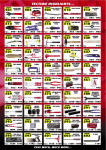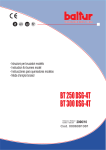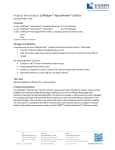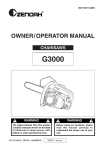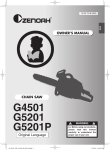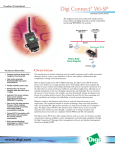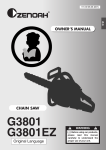Download Zenoah PE2500H Operator`s manual
Transcript
T1056-93510 (904) OPERATOR’S MANUAL WATER PUMP PE2500H WARNING • Before using our water pumps, please read this manual carefully to understand the proper use of your unit. • Keep this manual handy. SAFETY FIRST Instructions contained in warnings within this manual marked with a symbol concern critical points which must be taken into consideration to prevent possible serious bodily injury, and for this reason you are requested to read all such instructions carefully and follow them without fail. ■ WARNINGS IN THE MANUAL WARNING This mark indicates instructions which must be followed in order to prevent accidents which could lead to serious bodily injury or death. IMPORTANT This mark indicates instructions which must be followed, or it leads to mechanical failure, breakdown, or damage. NOTE This mark indicates hints or directions useful in the use of the product. 1. 2. 3. 4. 5. 6. 7. 8. 9. 10. CONTENTS Symbols carved on the machine ……………4 For safe operation ……………………………5 Parts location …………………………………7 Specifications …………………………………8 Fuel ……………………………………………9 Set up …………………………………………11 Operation ……………………………………12 Maintenance …………………………………15 Storage ………………………………………18 Troubleshooting guide ………………………19 1. Symbols carved on the machine For safe operation and maintenance, symbols are carved in relief on the machine. According to these indications, please be careful not to take a mistake. (a) The port to refuel the "MIX GASOLINE" Position: FUEL TANK CAP (b) The direction to close the choke Position: AIR CLEANER COVER (c) The direction to open the choke Position: AIR CLEANER COVER ❲4 ❳ 2. For safe operation • Before operating the machine, be sure to read through this manual carefully and follow proper operating instructions. • Never allow children or anyone unable to fully understand the instructions given in the manual to use the machine. ■ NOTES FOR OPERATION • Before using the machine, read this manual carefully to understand it’s function and safety instructions for operation. • Do not apply this pump for other than fresh water or agricultural water. Those cannot be applied are: Drinking Water, Muddy Water, Sea Water, Flammable Fluids(Such as Kerosene, Diesel Oil, Gasoline, or Heavy Oil), Chemical Agents, Acid or Alkaline Fluids, etc. • Engine exhaust gas contain hazardous carbon monoxide(CO). Avoid operating this pump indoors, in green house, tunnel, etc. where ventilation is imperfect. • Do not place any flammable object such as straw, withered leaves, rubbish, oily wiping cloth, etc. around the pump in operation. • Engine of this machine runs on the mixed fuel that contain highly flammable gasoline. Never refuel nor store the fuel where there is an incinerator, burner, open fire, stove, electric spark, welding arc spatter, etc. • Never smoke while refueling. It is absolutely hazardous. • Prior to refueling, be sure to stop the engine and confirm that there is no fire around. • Spilled fuel shall be completely wiped away with cloths, etc. before restarting the engine. • Securely tighten both fuel caps for the fuel tank and the fuel container after refueling. • Do not transport the pump for a long time on rough roads with fuel in the tank. Fuel cap may become loose with vibration and cause fuel leakage. • Keep children and pets away from where starting or operating the engine. ❲5 ❳ 2. For safe operation • Do not touch the spark plug or the plug wire while the engine is in operation. They may cause an electric shock. • Do not touch metallic parts such as the muffler, spark plug, etc. with bare hands during the operation of engine or immediately after a stop. They may be very hot and cause burns. • Apply isolation measures to keep children or infants away from the pump so that you can operate it in safe area. • Temperature of the pumping up water shall be in between 5°C to 60°C. Otherwise, the pump may be damaged. • Avoid idle pump operation(operation with no water in the pump). This may cause pump damage. • Be sure to use only attached suction hose or an equivalent “water suction hose” as an water inlet hose. • Make sure to couplings and clumps(attached to this kit) when connecting the suction and discharge hoses to the pump. • The engine shall be stopped to transfer pump. ■ NOTES FOR MAINTENANCE • In order to maintain your machine in proper condition, perform regular checking and maintenance described in this manual. In case you need a maintenance service or replacing of component not listed in this manual, consult with the shop of your purchase or nearby ZENOAH service dealers. • Be sure to stop the engine before any inspection or maintenance procedure. • Never disassemble nor modify your machine. This may cause damage of machine during operation and end up with serious accidents. • Always use ZENOAH genuine parts or ZENOAH specified parts for replacement. • Keep this manual handy so that you may refer back to it later whenever any doubt arises. • When you sell or lend this machine to others, never forget to attach this operator’s manual together. ❲6 ❳ 3. Parts Location 1. Air cleaner 2. Throttle lever 3. Spark plug 4. Handle 5. Self-suction plug 6. Discharge port 7. Suction port 8. Hose coupling 9. Clump 10. Suction hose 11. Strainer 12. Clump 13. Drain plug 14. Base 15. Fuel tank 16. Engine stop button 17. Fuel tank cap 18. Starter knob 19. Exhaust vent 20. Engine cover ❲7 ❳ 4. Specifications MODEL PE2500H Pump Type ················································································· Self suction type volute pump Suction/Discharge port diameter·········································································· 25 mm Total water head ·····································································································45 m Discharge(Max.) ·····························································································130 / min. Engine Type ························································································· Air-cooled 2cycle engine Model ·································································································· Zenoah G43LH-D Displacement······································································································· 41.5 cc Max. output···················································································· 1.75(HP)at 7200 rpm Fuel ······················································································· Mixture(Gasoline 25:Oil 1) Fuel tank capacity ································································································ 0.95 Max. operating time/Fuel charge ··························································· Approx. 40 min. Starting Method···························································································Recoil starter Overall size(L x W x H) ··················································································320 x 257 x 334 mm Dry weight·····························································································································7.5 kg Standard Accessories Suction hose(3m) ·········································································································· 1 Strainer·························································································································· 1 Hose coupling ··············································································································· 3 Clump·····························································································································3 Nipple 25x20 ··················································································································1 Screwdriver ····················································································································1 Plug wrench ·················································································································· 1 Specifications are subject to change without notice. ❲8 ❳ 5. Fuel WARNING • Gasoline is very flammable. Avoid smoking or bringing any flame or sparks near fuel. Make sure to stop the engine and allow it cool before refueling the unit. Select outdoor bare ground for fueling and move at least 3m(10ft) away from the fueling point before starting the engine. • The RedMax engines are lubricated by oil specially formulated for air-cooled 2-cycle gasoline engine use. If RedMax oil is not available, use an anti-oxidant added quality oil expressly labeled for air-cooled 2-cycle engine use.(FC GRADE OIL) RECOMMENDED MIXING RATIO GASOLINE 25:OIL 1 25:1 MIXING CHART GASOLINE Liter 1 2 3 4 5 2-CYCLE OIL ml 40 80 120 160 200 • Exhaust emission are controlled by the fundamental engine parameters and components(eq., carburation, ignition timing and port timing) without addition of any major hardware or the introduction of an inert material during combustion. • These engines are certified to operate on unleaded gasoline. • Make sure to use gasoline with a minimum octane number of 90 ROZ(USA/Canada : pump octane min.87) • Unleaded gasoline is recommended to reduce the contamination of the air for the sake of your health and the environment. • Poor quality gasolines or oils may damage sealing rings, fuel lines or fuel tank of the engine. ■ HOW TO MIX FUEL 1. Measure out the quantities of gasoline and oil to be mixed. 2. Put some of the gasoline into a clean, approved fuel container. 3. Pour in all of the oil and agitate well. 4. Pour in the rest of gasoline and agitate again for at least one minute. 5. Put a clear indication on the outside of the container to avoid mixing up with gasoline or ❲9 ❳ 5. Fuel other containers. 6. Indicate the contents on outside of container for easy identification. ■ FUELING THE UNIT 1. Untwist and remove the fuel cap. Rest the cap on a dustless place. 2. Put fuel into the fuel tank to 80% of the full capacity. 3. Fasten the fuel cap securely and wipe up any fuel spillage around the unit. WARNING 1. Select bare ground for fueling. 2. Move at least 10 feet(3 meters) away from the fueling point before starting the engine. 3. Stop the engine before refueling the unit. FOR YOUR ENGINE LIFE, AVOID; 1. FUEL WITH NO OIL(RAW GASOLINE) – It will cause severe damage to the internal engine parts very quickly. 2. GASOHOL – It can cause deterioration of rubber and/or plastic parts and disruption of engine lubrication. 3. OIL FOR 4-CYCLE ENGINE USE or WATER COOLED 2-CYCLE ENGINE USE – It can cause spark plug fouling, exhaust port blocking, or piston ring sticking. 4. Mixed fuels which have been left unused for a period of one month or more may clog the carburetor and result in the engine failing to operate properly. ❲ 10 ❳ 6. Set up IMPORTANT • As a suction hose, be sure to use attached suction hose(nominal diameter 25mm x 3m) or an equivalent ‘water suction hose’ only. • Securely connect hoses with attached hose couplings and clumps. • If the suction hose connection is loose, or a packing in hose coupling has been lost or damaged, air may be sucked into the pump and interrupt water suction (air lock). • A strainer shall be placed so that it does not appear above water level nor suck bottom sand and mud. F1 1. Place your pump at nearby water resource horizontally. 2. Insert attached hose couplings to the suction hose and discharge hose and tighten them with clumps. 3. After checking the packing of each hose coupling, connect the suction hose to a suction port and the discharge hose to a discharge port. NOTE Discharge port angle can be changed to 3 different directions. Adjust to your operating condition. F2 4. Submerge the suction hose strainer in the water. 5. Lay the discharge hose where necessary. Arrange protective covers if the hose can be disturbed by foot steps of others. 6. Remove self-suction plug and top up the pump with water. (F1) 7. Fill up fuel tank with fuel and tighten the tank cap securely. (F2) ❲ 11 ❳ 7. Operation WARNING • Fuel(Gasoline) is highly flammable and incorrect handling will cause fire accident. Strictly avoid smoking or fire during mixing or supplying the fuel. • Be sure to stop the engine and allow it to be cooled before refueling. • Spilled fuel shall be completely wiped away with wiping cloth, etc. before restarting the engine. • Do not leave any flammable object around engine exhaust port. WARNING Before starting the engine, check if there is anything that must not be wet near the discharge hose tip. Give warning to nearby people of starting water discharge. IMPORTANT • Idle operation with no water in the pump may cause pump damage. Before starting the engine, check if the pump is filled with selfsuction(priming) water. In case the suction strainer comes out of the water level during operation, immediately reduce the engine speed and stop the operation. • Confirm that the suction hose connection is not too loose. Loose connection may result in no suction water. • In case the discharge hose is clogged or a valve connected to the discharge hose is closed, the pump may not suck water. • Stepping on the discharge hose or sudden closure of the discharge valve may create instantaneous high pressure in the pump and result in pump damage(Water Hammer Effect). Arrange protective covers if the hose can be disturbed by others stepping on, and avoid closing the valve rapidly. ❲ 12 ❳ 7. Operation F3 ■ STARTING ENGINE 1. Push a priming pump at lower side of the carburetor several times until you can see the fuel flows into a clear tube. (F3) 2. Put the choke lever to CLOSE position, and set the throttle lever 1/3 to 1/2 open from fully returned position. (F3) NOTE Choke lever to OPEN for restarting immediately after stopping engine. F4 3. Confirm that the machine is stable on the ground. While holding the plug guard with your left hand, pull the starter knob with right hand. Starter knob shall be initially pulled gently, then vigorously when you feel resistance. (F4) IMPORTANT Avoid pulling out entire length of the rope or free returning of rope by releasing the knob. Doing this may cause starter failure. NOTE In case the engine does not start due to excess fuel, fully open the choke and throttle levers and repeat pulling the rope. Or take out the spark plug to dry and repeat the procedure. 4. When the engine is started, gradually open the choke lever, also return the throttle lever, and allow the engine 2 to 3 minutes of warming up at a low speed. 5. Operate the engine at a half throttle until the water in suction hose reaches the pump. As water discharge is started, adjust the throttle according to your required flow rate within the capacity. ❲ 13 ❳ 7. Operation ■ STOPPING ENGINE F5 WARNING In case of emergency, immediately stop the engine. 1. Return the throttle lever and run engine 1 to 2 minutes for cooling down. 2. Press the engine stop button(yellow) until the engine completely stops. (F5) F6 ■ AFTER USE 1. Release a drain plug at lower part of the pump and drain the water out of the pump. (F6) 2. Disconnect the hoses, clean them for storage. IMPORTANT During cold climate, be sure to drain the pump after every use. At an ambient temperature below freezing point, the water in the pump casing may freeze and damage the pump. ❲ 14 ❳ 8. Maintenance WARNING • Be sure to stop the engine and keep off fire for inspection and maintenance. • Always use our genuine parts/oils or our specified goods for replacement. ■ AIR CLEANER After every 25 hours of operation, release the air cleaner cover and remove dusts. In case the element is dirty, carefully wash it with warm water containing neutral detergent. Completely dry before refitting the element. If the element is deformed or damaged, replace it with new one. IMPORTANT F7 Clogged air cleaner spoils engine performance. Also, operation with no element or with deformed or damaged element causes irregular wear outs of the engine mechanism. NOTE To remove the air cleaner cover, disengage a clip on the light side of the cover first. When recovering, engage right side clip first. (F7) Element Part No.1750-82020 F8 ■ FUEL TANK After every 25 hours of operation, check inside of the tank and remove dirt or water if any. • Fuel Filter Remove any dirt. If the filter is badly clogged, replace with new one. (F8) • Fuel Tank Cap Check the air vent for choking with dirt. Remove dirt if any. (F8) IMPORTANT • Clogged fuel filter and choked vent valve reduce engine speed or cause unstable engine revolution. ❲ 15 ❳ 8. Maintenance • Operation with no fuel filter cause clogging of the carburetor. Fuel Filter Part No. 3302-85400 ■ SPARK PLUG F9 WARNING Do not touch the spark plug with bare hands immediately after stopping the engine. There is a possibility of burns by high temperature. After every 25 hours of operation, remove the spark plug and clean the electrode using wire brush, etc. (F9) Recommended plug gap is 0.6~0.7mm. Use the specified plug for replacement. IMPORTANT Excess fuel and poor quality oil may contaminate the plug electrode and end up with difficulty to start the engine. Specified Spark Plug Champion : CJ-6Y NGK : BPM7A ■ INTAKE AIR COOLING VENT F10 WARNING Never insert anything into the intake air cooling vent during engine operation. It may crush with internal rotating components. After every 25 hours of operation, check the intake air cooling vent and cylinder fins and remove any dirt. (F10) IMPORTANT Clogging of the air cooling vent and cylinder fins may cause overheating of the engine and result in engine failures. ❲ 16 ❳ 8. Maintenance F11 ■ ADJUSTING IDLE SPEED Engine idle speed is already adjusted at shipping. However, if the engine stalls due to too low engine speed when fully returning the throttle lever or if you feel it to be too high, adjust the speed. Idle adjusting screw is on the upper part of the carburetor. Engine speed increases with clockwise turning of the screw and decreases with counterclockwise turning. (F11) ❲ 17 ❳ 9. Storage ■ STORING FOR LONG PERIOD IMPORTANT F12 • To stop using your machine for a long period, drain fuel from the fuel tank and the carburetor before storing it. Fuel left behind inside there for long period may clog the carburetor and cause engine troubles as no starting of engine or reduced engine output. • Leave the fuel cap loose during storage. Over tightening may cause deform of packing. In case the pump is not used for more than 1 month, apply following maintenance procedures before storing it in dry, clean place: F13 ❲ 18 ❳ 1. Drain fuel from the fuel tank. (F12) 2. Fill the pump with water and start the engine at a low speed until it stops with no fuel. 3. Remove the spark plug and pour 1~2cc of 2 cycle engine oil into the cylinder, and pull the starter rope for 2~3 times. 4. Refit the spark plug. Pull the starter rope and return it when you feel a resistance. 5. Drain water from the pump completely, and wipe off water on the pump using dry cloth. (F13) 10. Troubleshooting guide STATUS Engine does not start CAUSE Faulty fuel(incorrect, degraded) Excess fuel sucked No suction of water Discharge water flow rate too small Exhaust muffler choked Spark plug electrode dirty, short or disconnected circuit Insufficient self-sucking water in pump Loose connection of suction hose Faulty packing in suction hose connection Suction hose crack breakage Folded discharge hose, closed valve Clogged suction strainer Pump position too high from water level Too far or too high place to discharge Engine output too low Water leakage from pump Loosen assembly bolts COUNTERMEASURE Change with proper fuel(see Page 9) Open choke and repeat pulling rope (see Page 13) cleaning Cleaning of electrode or replace plug (see Page 16) Top up with water(see Page 11) Tighten securely not to suck air Replace with proper one(ask for service) Replace with proper one Extend and stretch hose, open valve Cleaning of suction strainer Lowering pump height to water level Secure water resource near to discharge place Check fuel degrading, water ingress. Replace if needed(see Page 9) Check air filter clogging, cleaning (see Page 15) Check fuel filter clogging, cleaning (see Page 15) Carburetor adjustment Tightening of bolts If further assistance is needed, contact your authorized service dealer. ❲ 19 ❳ Warranty certificate Komatsu Zenoah Co. The Komatsu Zenoah product model No.PE2500H is covered by a Warranty of 6 months from the following date of purchase. In the case of professional machine used for professional work, such machines are covered by a Warranty of 3 months. We undertake according to our ability to supply free of charge all parts found defective at origin except in case where the defect can be traced back to either wrong manipulation or normal wear. Such excepted parts are not covered by this Warranty. Please address your complaints to the following address. 2-142-1 Sakuragaoka, Higashiyamato, Tokyo, 207-8788 Japan




















